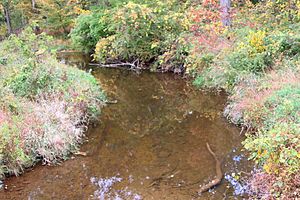Lick Run (Roaring Creek tributary) facts for kids
Quick facts for kids Lick Run |
|
|---|---|

Lick Run in its lower reaches
|
|
| Physical characteristics | |
| Main source | Locust Township, Columbia County, Pennsylvania |
| River mouth | Roaring Creek in Locust Township, Columbia County, Pennsylvania 810 ft (250 m) 40°53′51″N 76°23′17″W / 40.89741°N 76.38813°W |
| Length | 4.2 mi (6.8 km) |
| Basin features | |
| Basin size | 5.97 sq mi (15.5 km2) |
Lick Run is a small stream in Columbia County, Pennsylvania. It flows into a bigger stream called Roaring Creek. Lick Run is about 4.2 miles (6.8 km) long and is entirely within Locust Township. It's known for its cool water, which is perfect for fish like brown trout. In fact, 14 other types of fish and many tiny water creatures (called macroinvertebrates) also live here!
Contents
Where Lick Run Flows
Lick Run begins in the southern part of Locust Township, near a mountain. It flows generally towards the northeast, moving through the middle of Locust Township. Along its journey, it passes by the small community of Newlin. Eventually, Lick Run turns north again and flows into Roaring Creek. This meeting point is located southeast of a place called Slabtown.
Lick Run joins Roaring Creek about 14.08 miles (22.66 km) before Roaring Creek reaches its own end.
Stream Health and Features
Scientists check the health of Lick Run by giving it a score. A higher score means the stream is healthier. At one spot, near Poorhouse Road, Lick Run scored 16.5. Closer to where it meets Roaring Creek, near Mill Road, it scored 20.5.
Sometimes, the bottom of Lick Run can get covered with fine dirt and mud, which is called siltation. This happens more in the lower parts of the stream.
The water temperature of Lick Run was measured on July 31, 2003. About 2.24 miles (3.60 km) from its mouth, the water was 17.4 °C (63.3 °F). At the very end of the stream, where it joins Roaring Creek, the temperature was a bit warmer at 18.3 °C (64.9 °F) on the same day.
Lick Run is about 4.2 miles (6.8 km) long and about 3.8 metres (12 ft) wide. The stream drops in elevation by about 13.8 metres (45 ft) for every kilometer it flows. At its mouth, Lick Run is about 810 feet (250 m) above sea level.
The Lick Run Area
The area that Lick Run drains, called its watershed, covers about 5.97 square miles (15.5 km2). This watershed is found on maps known as the Catawissa, Mount Carmel, and Ashland United States Geological Survey quadrangles.
A lot of Lick Run is close to roads. About 56 percent of the stream is within 100 metres (330 ft) of a road, and almost all of it (97 percent) is within 300 metres (980 ft) of a road. Every part of the stream is within 500 metres (1,600 ft) of a road.
Most of the land around Lick Run is private property. About 70 percent of the stream flows through private land that is open for people to visit, while the other 30 percent is private and closed off. No part of the stream is on public land.
In the year 2000, about 30 people lived in each square kilometer of the Lick Run watershed.
Fish in Lick Run
Lick Run is known as a "coldwater fishery," which means its water is cool enough for fish that prefer colder temperatures. There's even a plan to make it a "high-quality coldwater fishery" because it's so good for fish. It's also a special "Class A Wild Trout Water" for brown trout, meaning it has a healthy population of wild brown trout. The Pennsylvania Fish and Boat Commission used to add fish to the stream until 1982.
You can find 15 different kinds of fish in Lick Run! These include brown trout, bass, sculpin, chub, suckers, and minnows. Ten types of fish live in the middle part of the stream, and 14 types are found near its mouth.
The amount of brown trout in the stream is quite good, with about 47.38 kilograms (104.5 lb) of fish per hectare. This amount has stayed pretty steady since 1976, except for one year in 1982 when there were fewer trout. Scientists estimate there are 64 brown trout longer than 7 inches (18 cm) for every kilometer of the stream. In the entire stream, there are an estimated 451 brown trout that are between 7 inches (18 cm) and 18 inches (46 cm) long.
Tiny Water Creatures (Macroinvertebrates)
Many small creatures, called macroinvertebrates, live in Lick Run. Near Poorhouse Road, you can often find Isonychiidae and Hydropsychidae. Scientists have seen 10 to 25 of each of these during surveys.
Other macroinvertebrates are less common, with 3 to 9 individuals seen. These include Cambaridae, Ephemerellidae, Peltoperlidae, Nigronia, Philoptamidae, and Rhyacophilidae.
Some types of macroinvertebrates are quite rare, with fewer than three individuals found during surveys. These include Oligochaeta, Turbellaria, Baetidae, Perlidae, and Ptilodactylidae.


